Note
0.0(0)
AP Art History Study Guides
AP Art History Ultimate Guide
Unit 1: Global Prehistory, 30,000–500 BCE
Unit 2: Ancient Mediterranean, 3500 BCE–300 CE
Unit 3: Early Europe and Colonial Americas, 200–1750 CE
Unit 4: Later Europe and Americas, 1750–1980 CE
Unit 5: Indigenous Americas, 1000 BCE–1980 CE
Unit 6: Africa, 1100–1980 CE
Unit 7: West and Central Asia, 500 BCE–1980 CE
Unit 8: South, East, and Southeast Asia, 300 BCE–1980 CE
Unit 9: The Pacific, 700-1980 CE
Unit 10: Global Contemporary, 1980 CE to Present
Studying for another AP Exam?
Check out our other AP study guides
Chapter 18: Art of New Spain: Spanish Colonies in the Americas
Key Notes
- Time Period: c. 1500–1820
- Culture, beliefs, and physical settings
- Baroque art can be found in New Spain.
- Baroque art still has a basis on classical formulas, but also has an interest in dynamic compositions and theatricality.
- Cultural interactions
- There are the beginnings of global commercial and artistic networks.
- Art in New Spain shows a willingness to absorb European, Asian, and indigenous American influences.
- Art in New Spain has a generally Catholic character similar to the art of southern Europe.
- Materials and Processes
- The period is dominated by an experimentation of visual elements, i.e., atmospheric perspective, a bold use of color, creative compositions, and an illusion of naturalism.
- Audience, functions, and patron
- There is a more pronounced identity and social status of the artist in society; the artist has more structured training opportunities.
- Theories and Interpretations
- Baroque art is studied in chronological order and by geographic region.
- There is a large body of primary source material housed in libraries and public institutions.
- Traditional art history material favors European art; the art of New Spain is often sidelined.
- This material is being presented here in a more comprehensive approach that highlights the interconnections between the Americas and Europe.
\
Historical Background
- After the news that Columbus had landed in what is now the Bahamas in 1492, European nations quickly embarked on a conquest and colonization effort.
- Spanish and Portuguese explorers conquered enormous swaths of territory in what is now known as Latin America.
- The great Native American civilizations of the Aztecs and Inkas succumbed to the more technologically advanced and disease-carrying Europeans.
- Local populace, including artists, were forced to labor for their European masters in a short period of time.
- Several Native Americans married within the established Spanish hierarchy, giving birth to mestizos.
- Mestizo: someone of mixed European and Native American descent
- The Spanish took advantage of much of what the New World had to offer, including silver, gold, and new crops such as potatoes and corn.
- They also developed a global commerce empire, with ships steadily sailing over the Pacific from Mexico to Asia.
- These trips, known as the Manila Galleon, allowed commerce vessels to complete the four-month trek without interruption.
- Even before they were available in the colonial United States, the Mexican market could claim Asian spices, ceramics, silks, ivory, and other valuable things.
- The touch of East and West on a Native American population improved artistic life.
- Nonetheless, the stability in Europe during the Napoleonic wars emboldened Spain's colonies to pursue independence.
- Spain's holdings were swiftly lost to talented generals such as Simón Bolivar and José de San Martín.
- By 1822, the majority of Latin America had become a patchwork of independent governments; colonial rule had ended.
Patronage and Artistic Life
- The Spanish introduced the New World to Roman Catholicism, a faith rich in imagery. Religious benefactors funded a staggering number of high-quality religious works.
- Unlike English colonists, the Spaniards were not hesitant to employ indigenous artists.
- Modern Spanish works mix Roman Catholicism and Native American traditions in a pictorial landscape that frequently incorporates new materials from Asia.
- Likewise, English Protestants in what is now the United States focused on portraiture.
- Initially, the Spaniards carried late medieval aesthetic conventions with them, which were frequently blended with provincial Renaissance masterpieces.
- Soon after, efforts were undertaken to construct local schools inspired by the more contemporary Baroque design.
- Several Mexican photographs depict men dressed in the newest Madrid fashions to demonstrate their aristocratic sensibility.
- Cusco, Peru, became the first European art center in the Americas.
- Local Quechan and mestizo artists were taught the newly imported style by Spanish painters.
- Patrons were interested in portraits, as well as other topics popular in European painting at the time, such as historical paintings of war scenes and Arcadian landscapes.
\
Painting in New Spain
- Religious painting from the colonial Spanish era is distinguished by a blend of Old and New World techniques.
- The oil technique and Catholic iconography were introduced to American painting by Spain.
- Native artists who worked within their own traditions were less interested in European painting formulae like perspective.
- They preferred a flat surface with clay tones.
- This is especially noticeable in the works of the Cusco School.
- Numerous works of art were created anonymously, in the service of religion rather than the artist's renown.
- Because the style of a certain school is so tightly aligned now, it is often impossible to determine the artist's name.
- The Manila Galleon brought trade from Asia as well as new materials, therefore it is not uncommon to witness pieces of Latin American art that employ ivory, silk, or ceramics.
➼ Frontispiece of the Codex Mendoza
Details
- Viceroyalty of New Spain
- c. 1541–1542
- Made of ink and color on paper
- Found in Bodleian Library, Oxford University
Content
- The main scene depicts the founding of Tenochtitlán; below is the conquest of Colhuacan and Tenayucan.
- Aztecs were told to found their city at the spot where an eagle was perched on a cactus growing from a rock—today this is the symbol used on the Mexican flag.
- An eagle landing on a cactus at the intersection of the two waterways commemorates the division of Tenochtitlán into four quarters.
- Enemy temples are on fire; Aztec warriors carry clubs and shields.
- Skulls represent sacrificial victims.
- There is a small representation of the Templo Mayor above the eagle.
Function
- The book was intended as a history of the Aztecs for Charles V of the Holy Roman Empire—although he never received it.
- Named after Antonio de Mendoza, viceroy of New Spain.
- Viceroy: a person appointed to rule a country as the deputy of the sovereign
Context
- The book was created 20 years after the Spanish conquest.
- The book depicts Aztec rulers and daily life in Mexico to a European audience.
- The book uses glyphs created by Aztec artists that were later annotated in Spanish.
Image
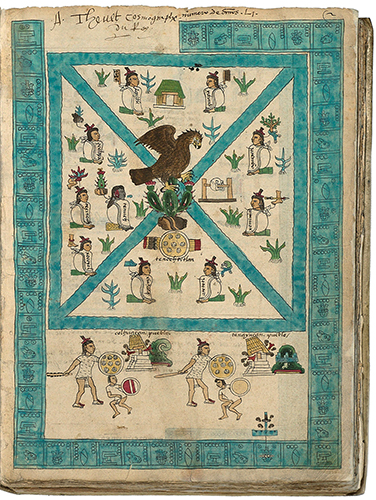
\
➼ Angel with Arquebus (Asiel Timor Dei)
Details
- Master of Calamarca (La Paz School)
- 17th century
- Made of oil on canvas
- Found in National Art Museum, La Paz, Bolivia
Content
- Latin inscription: Asiel, fear of God.
- The angel is depicted with an arquebus (a form of rifle) instead of a traditional sword.
- An arquebus is a state-of-the-art weapon brought by the Spanish to the New World.
Form
- The elongated hat with feathers is a feature of dress of Inkan nobility.
- Indigenous people favored gold embroidered on fabrics.
- Military poses are derived from European engravings of military exercises.
- The drapery is of a seventeenth-century Spanish-American aristocrat; rich costuming.
- The angel appears in an androgynous stance.
- Mannerist influence in the stiffness of the figure and dance-like pose.
Function: Probably one in a series of angel drummers, buglers, standard bearers, and holders of swords.
Context
- A relationship is expressed between this kind of image and the winged warriors of pre-Columbian art.
- The work may have originated in the region around Lake Titicaca, in the Collao region of Peru.
- The Master of Calamarca may have been José López de los Ríos, a Bolivian painter.
- The feathered hat may reference Andean royalty.
- Guns were symbols of power and dominance over native American peoples and their beliefs.
- The painting is related to Spanish-American writings that allude to angels coming at the Last Judgment well-attired with feathered hats and carrying guns.
Image
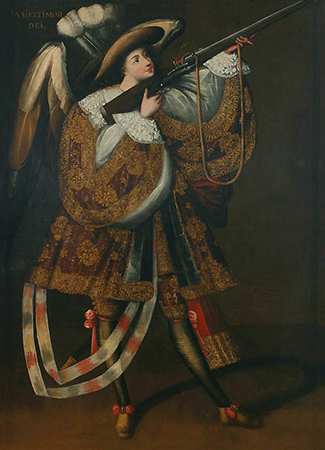
➼ Screen with the Siege of Belgrade and a hunting scene
Details
- Circle of the González family
- 1697–1701
- Made of tempera and resin on wood inlaid with mother-of-pearl
- Found in Brooklyn Museum, New York
Form
- Only known example of an artwork that combines biombos and enconchados.
- Biombos: folding freestanding screens
- Enconchados: shell-inlay paintings; tiny fragments of mother-of-pearl placed onto a wooden support and canvas and covered with a yellowish tint and thin glazes of paint
Function and Patronage
- The screen was commissioned by José Sarmiento de Valladares, viceroy of New Spain.
- Displayed in Viceregal Palace in Mexico City.
- The screen was meant to divide a space into smaller areas; similar to Japanese screens in function.
- Only half of the screen is illustrated in the official image set; the other half is in Mexico City.
Context
- Two faces of the screen: one has a hunting scene, and the other has a war scene (the Siege of Belgrade).
- The hunting scene is suited to an intimate space for small receptions.
- The hunting scene is based on tapestry designs for the Medici, a great family of art patrons in Renaissance Italy; the design is derived from prints exported from Europe.
- The war scene is more suited for a grander room of political importance.
- The war scene depicts the contemporary event of the Great Turkish War (1683–1699); a Dutch print was used for inspiration.
- The war scene illustrates a scene of Hapsburg power.
- Lacquer-style imported works from Japan influenced the decorative floral elements and the landscape motifs.
Images

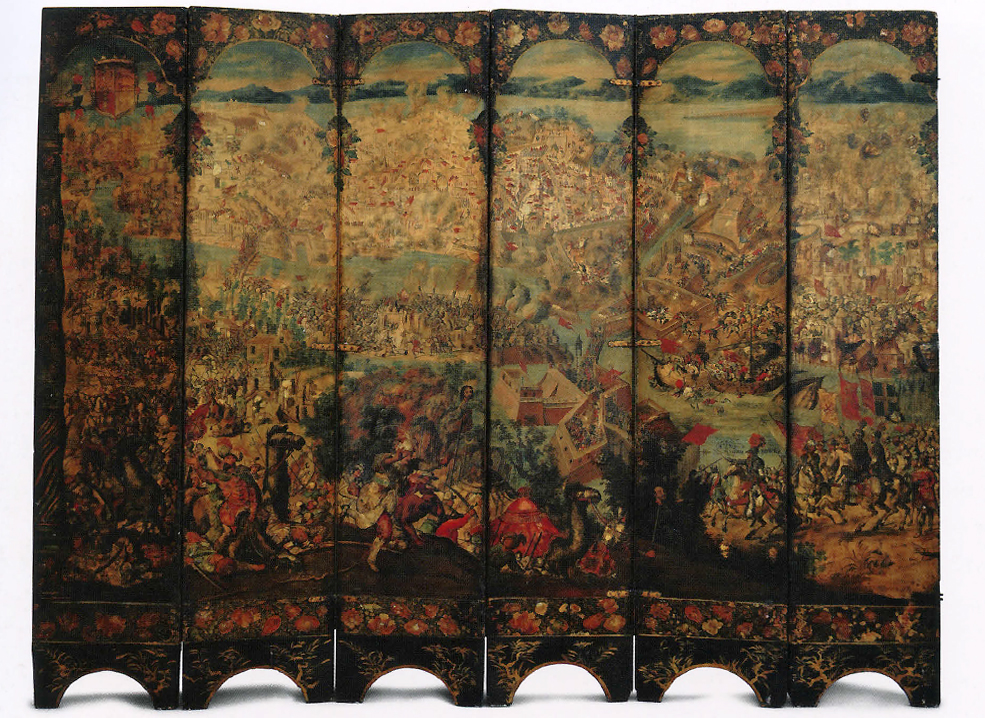
\
➼ Virgin of Guadalupe (Virgen de Guadalupe)
Details
- By Miguel González
- Based on original Virgin of Guadalupe
- From Basilica of Guadalupe, Mexico City, 1698
- Made of oil on canvas on wood inlaid with mother-of-pearl
- Found in Los Angeles County Museum of Art, Los Angeles, California
Form
- The Virgin Mary is surrounded by four roundels that tell the story of the Virgin of Guadalupe.
- In the roundels there are depictions of her appearance to Juan Diego, and the moment the Virgin’s image is revealed on his tunic.
Materials
- Brocade on Virgin’s robes made of enconchados.
- Enconchado paintings often include ornate frames inspired by Japanese Nanban lacquer work.
- Enconchado paintings have a luminous and vibrant color patterning that enhance the other-worldly effect that this object represents.
Context
- The painting describes an event in which Mary appeared to Native Americans on a hill called Tepeyac, a shrine sacred to a pre-Columbian goddess.
- In 1531 Mary ordered a Native American convert, Juan Diego, to tell the local archbishop to build a sanctuary on this site; Mary addressed Juan Diego in Nuhuatl, his native tongue.
- Mary made the hilltop flower, and Juan Diego brought the flowers to the archbishop; Juan Diego’s cloth revealed the Virgin’s image.
- The Virgin of Guadalupe is the most revered symbol in Mexico and the patroness of New Spain.
- In Guadalupe images, Mary always stands on a crescent moon surrounded by sunrays with clouds behind her.
- An eagle perched on a cactus at bottom center is a symbol of Mexico today.
- Cf. Revelations 12:1: “A great sign appeared in heaven: a woman clothed with the sun, with the moon under her feet and a crown of twelve stars on her head.”
- Image was in demand: many made for export around New Spain.
Image
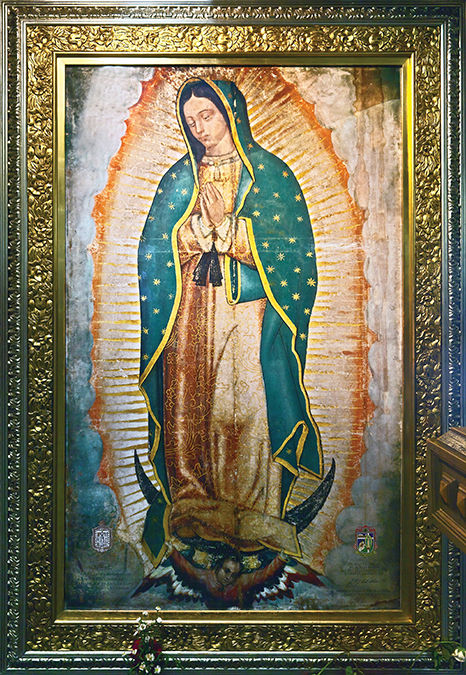
➼ Spaniard and Indian Produce a Mestizo
Details
- Attributed to Juan Rodríguez Juárez
- c. 1715
- Made of oil on canvas
- Found in Breamore House, Hampshire, United Kingdom
Form
- A Spanish gentleman married an indigenous woman and produced a mestizo, who is carried on the back of a servant.
- Many Africans and Indians are rendered with Southern European features: slim noses, curly hair, almond-shaped eyes.
Function
- Spanish colonists commissioned these works to be sent abroad to show the caste system of the New World.
- Not considered art objects but illustrations of ethnic groups.
Context
- Panel from the first known series of casta paintings; may not have been a completed set.
- Casta paintings: paintings from New Spain showing people of mixed races
- Spanish social hierarchy with the European ancestry at the top; sixteen different gradations on the social scale.
- Spanish blood linked to civilizing forces; wearing lavish costumes.
- Africans and Indians are rendered with respect; showing harmony and mixing of the classes.
Image:
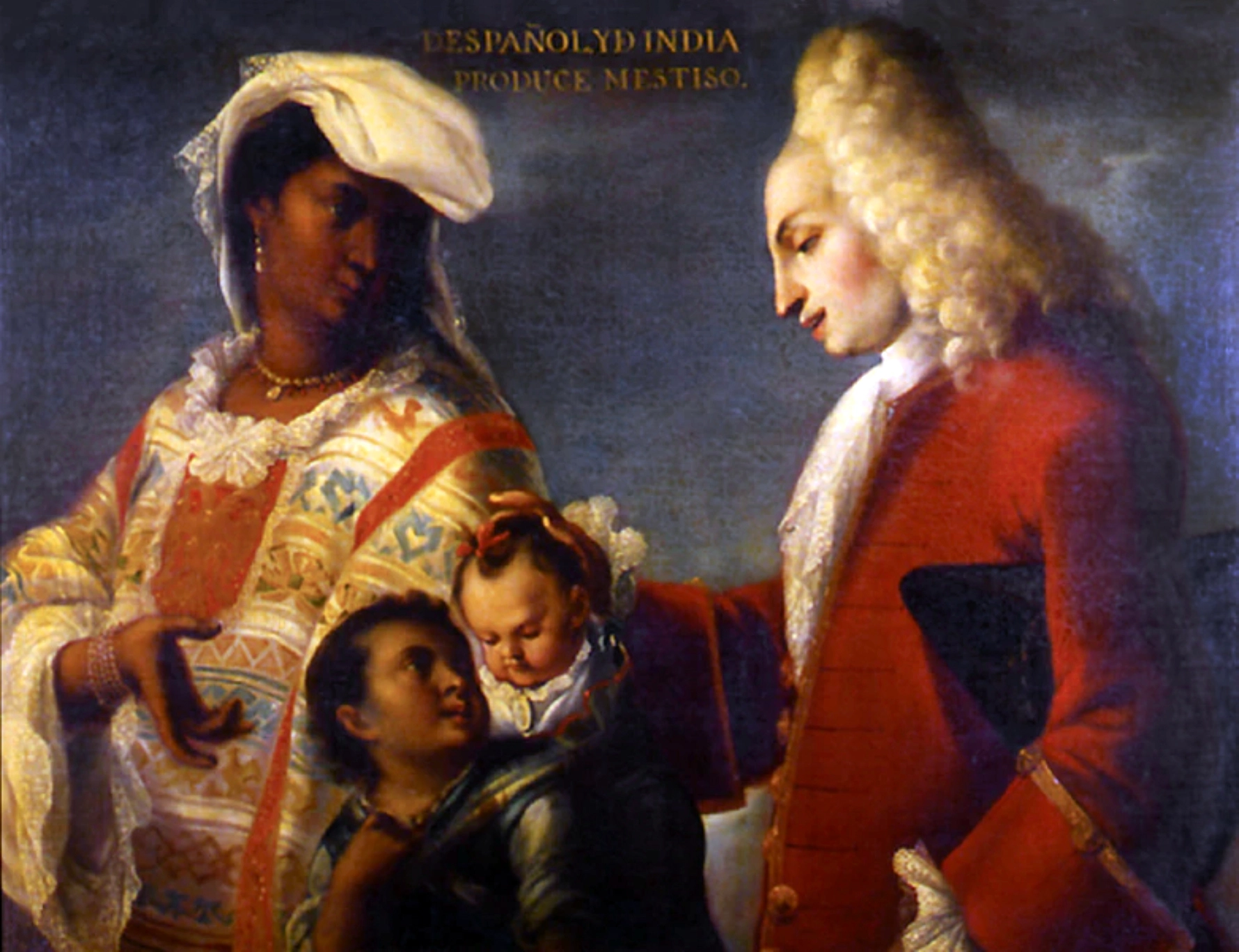
➼ Portrait of Sor Juana Inés de la Cruz
Details
- By Miguel Cabrera
- 1750
- Made oil on canvas
- Found in Museo Nacional de Historia, Castillo de Chapultepec, Mexico
Function
- Many portraits survive, but all images derive from a now-lost self-portrait.
- Painting was done for her admirers 55 years after Sor Juana Inés’s death.
Content
- Portrayed seated in her library surrounded by symbols of her faith and her learning.
- She wears the habit of the religious order of the Hermits of Saint Jerome nuns of Mexico City; the habit includes the escudo—a framed vellum painting.
- Painting may have been inspired by the image of Saint Jerome seated at a desk.
- Escudo: a framed painting worn below the neck in a colonial Spanish painting
Context
- Sor Juana Inés (Sister Juana Agnes), a child prodigy (1651–1695).
- She was a criollo woman who became a nun in 1669.
- A feminist culture survived in Mexican convents, where privileged nuns could live in comfort with servants and households.
- Sor Juana was a literary figure who wrote books that were widely read; she also wrote poetry and theatrical pieces, and maintained a great library.
- Sor Juana was instrumental in giving girls an education in a male-dominated world.
Image
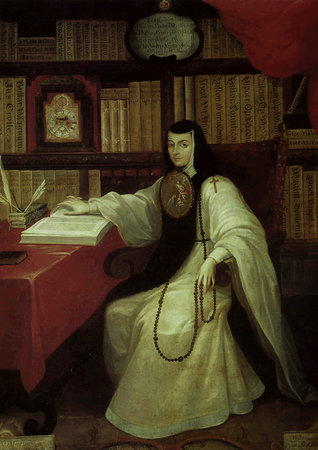
\
Note
0.0(0)
AP Art History Study Guides
AP Art History Ultimate Guide
Unit 1: Global Prehistory, 30,000–500 BCE
Unit 2: Ancient Mediterranean, 3500 BCE–300 CE
Unit 3: Early Europe and Colonial Americas, 200–1750 CE
Unit 4: Later Europe and Americas, 1750–1980 CE
Unit 5: Indigenous Americas, 1000 BCE–1980 CE
Unit 6: Africa, 1100–1980 CE
Unit 7: West and Central Asia, 500 BCE–1980 CE
Unit 8: South, East, and Southeast Asia, 300 BCE–1980 CE
Unit 9: The Pacific, 700-1980 CE
Unit 10: Global Contemporary, 1980 CE to Present
Studying for another AP Exam?
Check out our other AP study guides